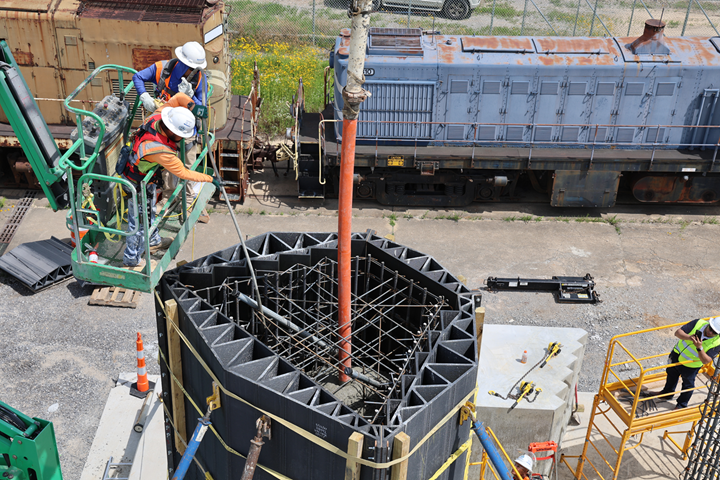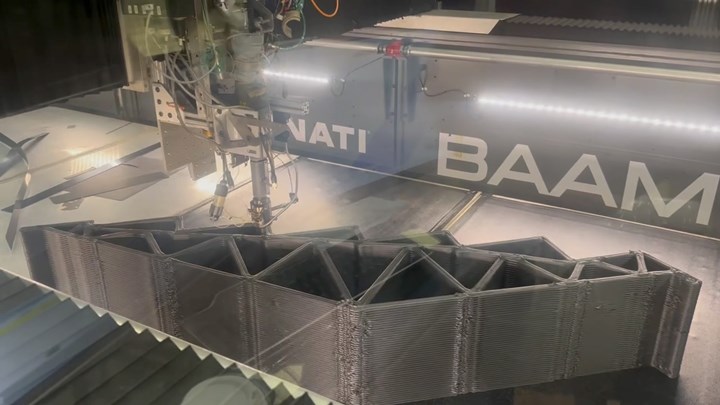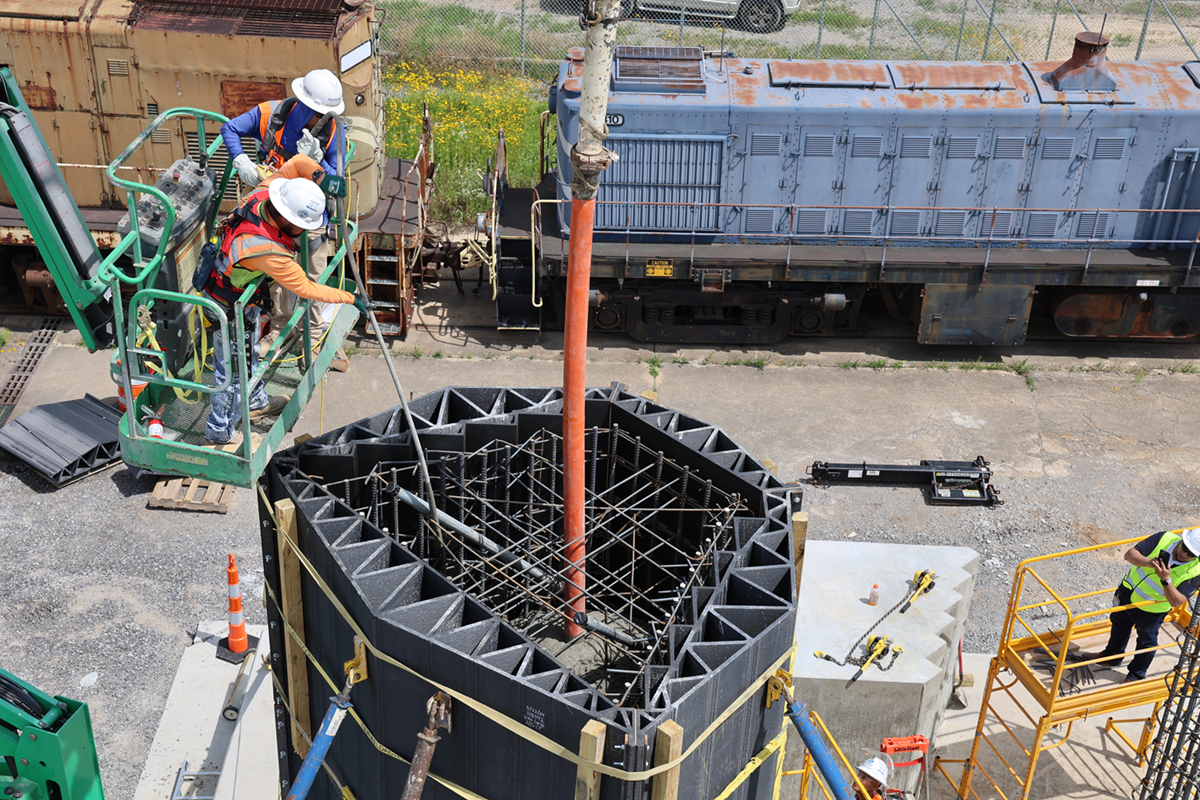
One of Kairos Power's goals in its nuclear fission technology demonstration plant is to accelerate the construction of nuclear power plants. In an initial project with Oak Ridge National Laboratory (ORNL), Kairos designed and built a 42-foot-long cast-in-place concrete bioshield column made possible by using rapidly developed, high-precision 3D printed composite molds (shown in black). Source (All images) | Kairos power
Kairos Power (Alameda, California, USA) began construction of its Hermes low-power demonstration reactor in Oak Ridge, Tennessee in July 2024. Once completed in the next few years, the site will serve as a test bed for the company's fluoride salt-cooled high-temperature reactor (KP-FHR) nuclear fission technology; The findings from this first reactor will also be incorporated into the construction of a second, larger Hermes 2 reactor at the same location.
In May 2025, Kairos Power began building nuclear safety-related components for the first Hermes reactor. A challenging aspect of this design phase was the development of a complex, 42-foot-tall concrete shielding structure, or “bioshield,” surrounding the reactor vessel to protect workers from radiation during operation.
Round or square concrete bioshields are typically constructed as monolithic, cast-in-place structures around nuclear reactors. Kairos Power's design for the Hermes demonstration reactor aimed to simplify construction by dividing the bioshield into modular sections. The structure consists of four corner pillars supporting four concrete slabs connected with zigzag joints to prevent radiation leaks at the seams.
“I think there is a lot of bold nuclear ambition and a lot of opportunity in that area right now.”
In addition to demonstrating and testing the design, Kairos also wanted to work on manufacturing processes that would support future scale-up plans. “In the past, Kairos has been keen to accelerate the construction of nuclear power plants, but finding the best way to build plants in an efficient and economical manner has been a challenge in this industry,” explains Edward Blandford, CTO and co-founder of Kairos Power.
Kairos initially investigated the use of precast concrete to reduce on-site installation time and spoke with Gate Precast Co. (Jacksonville, Florida, USA). One project Gate Precast successfully completed several years ago that was of interest to Kairos was a series of geometrically complex prefabricated concrete window facades for a high-rise building in Brooklyn, New York. These were manufactured at Gate's manufacturing site, using primarily 3D printed carbon fiber reinforced composite molds instead of traditional wooden molds, developed in collaboration with the Department of Energy (DOE) Manufacturing Demonstration Facility (MDF) at Oak Ridge National Laboratory (ORNL, Tennessee, USA). USA).

The first demonstration included three columns arranged like a radiation symbol. In practice, four corner columns would be connected via concrete slabs to surround a reactor.
It turns out that the MDF is only a 15 minute drive from the Hermes location, so of course Gate Precast connected Cairos to ORNL. “We started looking into what Gate had done with ORNL, and it was pretty interesting,” Blandford says. “If we were just making simple cubes, 3D printing would be a very inefficient method. You would just take large shapes made of metal or wood and move on. What ORNL has done is develop a process to make very quickly more complex geometries that are difficult to make using traditional means; that is where the real opportunity lies.”
He also adds, “We were able to leverage all of the work that Oak Ridge had done in developing their large-scale carbon fiber composite 3D printing. Much of this early work was already risk-free and we were able to easily leverage it for our specific application.” [See sidebar below for more on ORNL’s work in large-format additive manufacturing (LFAM).]
The partners ultimately received funding through DOE's multi-year SM2ART Moonshot project, co-led by MDF with the University of Maine (UMaine, Orono, USA), and began developing plans for the shielding demonstration.
Design of the shapes: complex geometry, tight tolerances, high pressure
While precast concrete and pre-assembly remain goals for Kairos' reactor deployment, for this demonstration, three columns would be cast in place using the 3D printed composite molds.
Based on Kairos' column designs, ORNL, with assistance from Kairos, designed and simulated the forms to be printed. Each of the three shapes consists of three 10×10 foot pieces that can be stacked and connected together like high-precision Lego bricks.

For this project, the forms from each manufacturer were transported to the Hermes location. In the future, Kairos is also aiming for the possibility of external pre-assembly.
“There were two extreme challenges – the geometry and the tolerance,” explains Ahmed Elhattab, lead engineer at Kairos Power. The zigzag shape is designed to most effectively prevent radiation leakage and provide connectivity to the rest of the bioshield. It required a tolerance of 1/16 inch. “That's why we needed the 3D printed composites. You can create the geometry with wood. But achieving the tolerances is an extreme challenge.”
Another challenge was ensuring that the forms could withstand the pressure created by pouring the 40-foot-tall concrete column. For this demonstration, the molds were designed to withstand pressure up to 20 psi. “To give perspective,” notes Elhattab: “Normal molds are designed for a fifth of this value, so we generally cannot exceed the maximum pouring height of each 1.20 m high concrete section. The concrete then has to harden before pouring can begin. In this project we have shown that we can go up to a pouring height of 2.40 m.”
Ryan Dehoff, director of MDF at ORNL, explains that while he and his team designed the form, the printing process also had to be designed and adjusted accordingly. “At Kairos, geometric accuracy and tolerance are of course very important. That's why we collected print data from the first prints along the way to give a certain level of understanding of the accuracy of the printing process. We also overlay this print data with the actual geometric data from a light scanner and can thus ensure the quality of the final part.” Modifications were made to the printing process, for example to achieve better adhesion between layers during printing.

The MDF at ORNL, along with manufacturing partners, conducted several initial test prints and contributed final demonstration molds.
The final three forms were printed using chopped carbon fiber/ABS pellets from Airtech (Huntington Beach, California, USA). Dehoff notes, “All of this work was done with raw materials that we have worked extensively with in the past, so the risk of understanding how these materials will behave was quite low.”
To reduce printing time, MDF and its partners Additive Engineering Solutions (AES, Akron, Ohio, USA) and Haddy (St. Petersburg, Florida, USA) each printed and processed the three stackable parts of a form. These were all transported to the Hermes location for assembly.
Each printing company used the same design and source material, but different large format printers. “There is no dramatic difference between them, which I think is a very promising result overall. There are many opportunities in the industry to implement these types of technologies,” says Dehoff.
14-day success story and long-term ambitions
The entire project, from initial draft to final 3D printed form, took just 14 days. In comparison, if it had been made from wood or steel, it would have taken at least six weeks, says Elhattab. “It was extremely impressive, especially considering that these were three identical products from different companies.”
And unlike a wooden mold, which can only be reused a few times, “composite molds are very reusable—we can do hundreds of castings in these materials,” says Dehoff. “It really changes the economy depending on what you try to do.” For example, Kairos could develop a scalable commercial version of its nuclear facility and establish a design concept so that the molds could be reused to build standardized structures at multiple sites.

Part of the construction team stands in front of a support under construction while concreting.
What's next? This demonstration serves as a precursor to the columns that will ultimately be built and tested as part of the Hermes reactor building. Through the SM2ART project, Kairos and ORNL continue to develop and optimize the technology and materials.
“Now that we know this is a viable method, we can incorporate it into our design approach. The ability to test early, prototype and get that input is critical. The expediency is helpful,” says Blandford.
“We are currently scaling up and looking at how we can apply different materials,” adds Elhattab. These include lower-cost fiberglass and even bio-derived raw materials with ORNL's partner, the UMaine Advanced Structures and Composites Center. The partners are also working on even larger shapes using UMaine's large-format 3D printer.
Dehoff concludes: “I think there is a lot of bold ambition in the nuclear space right now and there is a lot of opportunity in this area. Developing these unique applications to make this possible – and not only that, but also reducing costs and shortening time to market – is exactly in line with our goals.”
